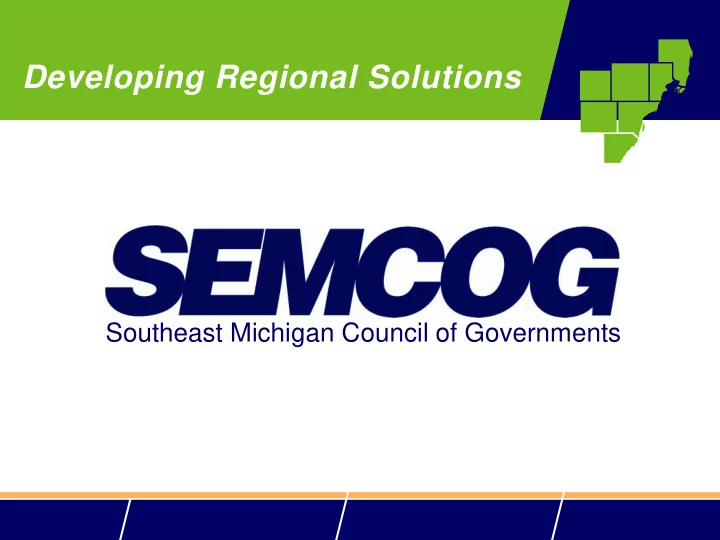

Developing Regional Solutions Southeast Michigan Council of Governments
GREEN INFRASTRUCTURE PLANNING FOR SOUTHEAST MICHIGAN Katie Grantham SEMCOG
Agenda 1. An Overview of SEMCOG’s Work 2. Green Infrastructure and Southeast Michigan 3. SEMCOG’s Green Infrastructure Planning 4. SEMCOG’s Green Infrastructure Work
What is SEMCOG? Association of over 170 local governments – Transportation – Infrastructure – Environment – Economic Development – Bicycle and Pedestrian – Parks and Recreation – Regional Forecasting
SEMCOG Vision The people of Southeast Michigan benefit from a connected, thriving region of small towns, dynamic urban centers, active waterfronts , diverse neighborhoods, premier educational institutions, and abundant agricultural, recreational and natural areas.
Green Infrastructure and Southeast Michigan
Green Infrastructure in Southeast MI
Southeast Michigan has… • 7 counties • 4,700 square miles • 4.7 Million population • 44% Residential Detroit • 26% Agricultural • 15% Impervious • 30% Tree Canopy • 50% Open Space
SEMCOG Green Infrastructure Planning
Green Infrastructure Plans
Green Infrastructure Vision • Quality • Connectivity • Water Quality • Air Quality • Transportation • Economy
Green Infrastructure Vision Regional Policies: Southeast Michigan’s infrastructure is a network that needs to be managed • as a system. Green infrastructure should focus on connecting the public network • together, focusing on riparian corridors and trails. Public accessibility is fundamental to the green infrastructure network. • Increasing tree canopy is a priority. • The transportation network is a key component of the regional green • infrastructure system. Education and promotion of green infrastructure is necessary. •
Green Infrastructure Vision Local Governments Role: Adopting GI policies • Educate • Update zoning ordinances • and land use plans Evaluate vacant parcels for • greening potential Identify GI potential in road, • water, and sewer infrastructure projects Consider native plant use •
Water Resource Plan • Preserve and restore natural areas • Protect and restore aquatic habitats • Coordinated asset management • Flexible jurisdictions for stormwater management
Parks and Recreation Plan Regional Policies: Integrate community health • Ensure Equitable Access • Promote the economic value • Support Conservation and • Stewardship Raise awareness • Foster Collaboration •
2045 Regional Transportation Plan • 2045 RTP – 20-year horizon – $35 billion; 174 projects through 2045 • Transportation Improvement Program – 4-year horizon – 2017-2020 – $4.4 billion
Environmental & Infrastructure Priorities
RTP Policies and Actions Integrate Environmental Protection into the transportation system, enhancing community health and increasing the overall resiliency of infrastructure Integrate environmental elements into the early transportation planning • process. Utilize the environmental sensitivity analysis to inform transportation • agencies of potential impacts. Support and facilitate collaboration between road agencies and local • jurisdictions regarding stormwater management opportunities. Complete a climate resiliency analysis for regional transportation assets. • Reduce stormwater water runoff entering combined sewer systems using • green infrastructure or other stormwater management techniques.
Partnerships & Stakeholder Groups Local planners and local governments • Multiple Watershed Groups • Lake St. Clair CISMA • Green Infrastructure Task Force • Huron-Clinton Metroparks • EGLE • Water Resources Task Force • Parks and Recreation Task Force • GLWA Committees (One Water Partnership; Master • Plan; Best Practices; Public Education)
SEMCOG’s Green Infrastructure Work
Transportation Alternatives Program (TAP) Funding Opportunities for Transportation Improvements: Bike & Pedestrian Safety • Historic Preservation • Environmental Mitigation • Activities Safe Routes to School •
Multi-Community Planning Grants • Norton Creek Watershed Green Infrastructure Planning • George W. Kuhn Basin Green Infrastructure Code Changes
Green Infrastructure • EPA GLRI • $265,000 for implementation • Lake Erie drainage – Majority of region – Nutrient reduction priority • County + EGLE
Questions?
Recommend
More recommend